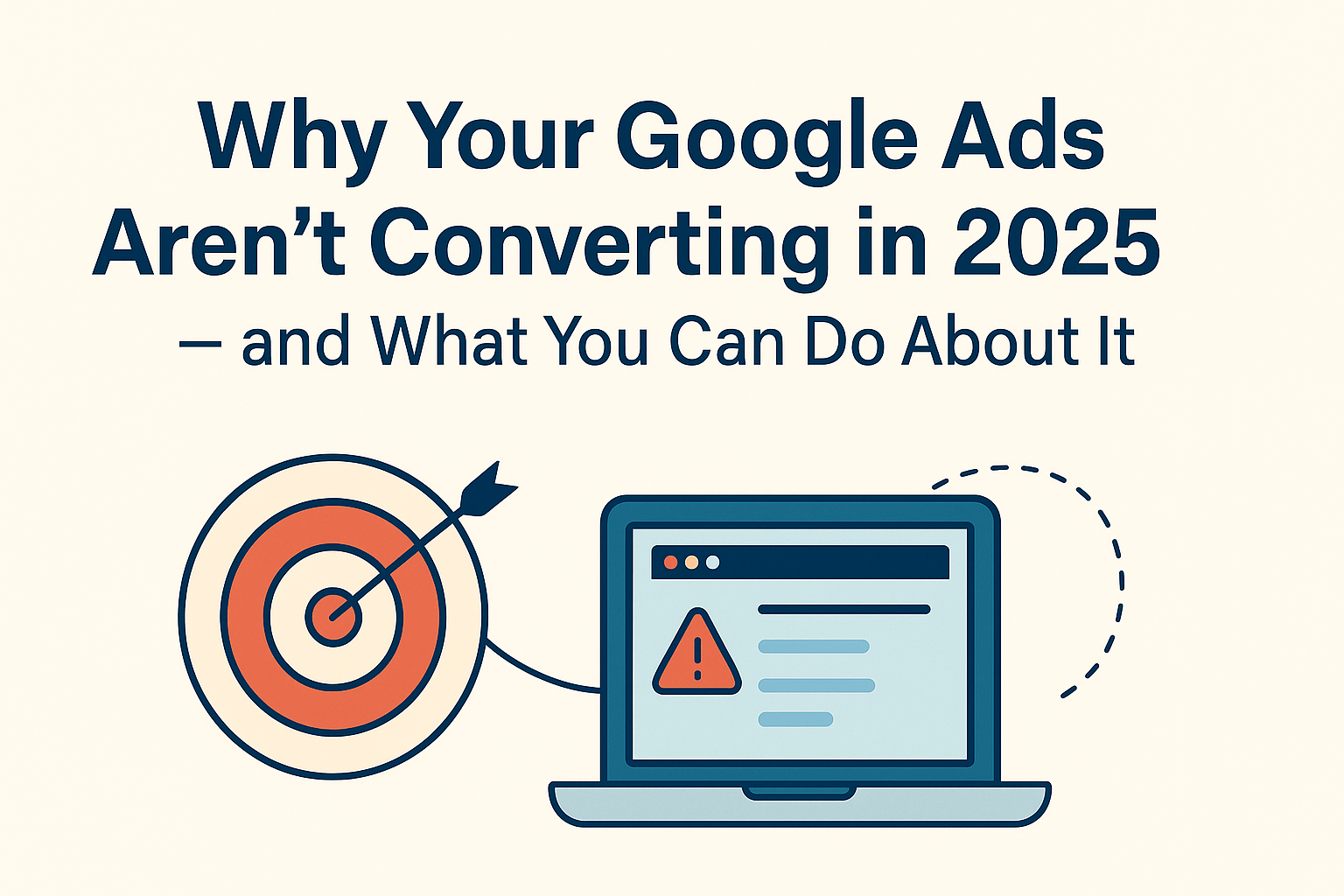Michael Green | June 9, 2025
Why Your Google Ads Aren’t Converting in 2025 — and What You Can Do About It

You’re getting plenty of clicks on your Google Ads, but conversions just aren’t happening. No calls. No form submissions. No sales. Sound familiar? You’re not alone.
In 2025, Google Ads is more advanced and competitive than ever. Success requires more than running ads — it requires precision across the entire funnel. From the moment someone sees your ad to the second they convert, every detail matters.
This guide reveals why your Google Ads may not be converting and how to fix each issue — fast.
1. Your Website Isn’t Ready to Convert
Your ads may be doing their job, but if your website doesn’t deliver, people leave. A visitor should know what you do, why you’re credible, and how to take action — within seconds.
Common issues:- The page loads in more than 2 seconds
- The mobile experience is clunky
- No trust signals (e.g., reviews, logos, security badges)
- The call-to-action is hard to find or unclear
- Test your page speed using PageSpeed Insights
- Add visual trust signals like Google reviews and certifications
- Place your headline and offer above the fold
- Use a clear CTA — e.g., “Book Now” or “Get a Free Quote”
- Simplify your forms — fewer fields = more completions
2. You’re Targeting the Wrong Keywords
Getting traffic isn’t the same as getting leads. If you’re targeting broad or low-intent keywords, you’re likely paying for unqualified clicks.
Fix it:- Use phrase or exact match instead of broad match
- Add negative keywords regularly (review Search Terms Report weekly)
- Focus on commercial and transactional keywords like “hire,” “schedule,” “buy”
- Remove research-focused terms unless you have a nurturing funnel
Intent matters more than volume. A keyword like “emergency AC repair near me” will convert better than “air conditioner tips.”
3. Your Ads Are Showing in the Wrong Locations
Many advertisers waste budget on clicks from places they don’t even serve. This happens when Google shows your ads to people “interested” in your area rather than physically present.
Fix it:- In location settings, choose “Presence” only (not “Presence or interest”)
- Exclude countries, regions, or cities outside your service area
- Use geographic bid adjustments to favor profitable areas
Also, use the Locations report to find where your traffic actually comes from.
4. Your Ad and Landing Page Don’t Match
If someone clicks on an ad about “50% Off Drain Cleaning” and lands on your homepage with no mention of that deal, they’ll bounce. Mismatch equals distrust.
Fix it:- Match your landing page headline to the ad text
- Repeat key messaging and offers from the ad on the page
- Keep your message focused on one goal — don’t link out to unrelated pages
Consistency improves Quality Score and builds trust.
5. You’re Not Tracking Conversions Correctly
If you don’t track conversions, you’re flying blind. You can’t optimize what you don’t measure.
Get it right:- Use Google Tag Manager to manage your tracking
- Turn on Enhanced Conversions in Google Ads
- Track every meaningful action: form submissions, calls, purchases
- Regularly test your tracking setup (use Tag Assistant)
- Also, read our Clixtell article to understand why proper tracking is essential for PPC.
6. You’re Not Using Conversion Intelligence
Basic tracking tells you what happened. Conversion intelligence tells you why — and what to do next.
Try this:- Learn which campaigns and keywords bring the best leads
- See what device, location, or ad drove the call or form submission
This gives you the data to scale what works and stop what doesn’t.
7. You’re Missing Phone Call Leads
In many industries, calls convert better than forms. If you’re not tracking them, you’re underreporting results.
Fix it:- Use dynamic phone numbers that change by traffic source
- Integrate phone call tracking with Google Ads
- Review call durations to distinguish real leads from spam
Call analytics show you how people really interact with your business.
8. Your Campaigns Are Disorganized
A messy campaign structure confuses Google’s algorithms and muddies your reporting.
Fix it:- Use separate campaigns for different services, goals, or locations
- Create tightly themed ad groups (e.g., don’t mix “HVAC repair” and “plumbing”)
- Assign dedicated budgets to high-performing segments
Cleaner structure = better data = better results.
9. You’re Paying Too Much Per Click
High CPCs are common in 2025 — but they’re not inevitable. Quality Score can cut your costs dramatically.
What to do:- Write relevant ad copy that matches your keywords
- Improve your landing page experience
- Test Responsive Search Ads with multiple headlines and descriptions
- Use in-market and retargeting audiences
Remember: High intent + high relevance = lower cost per conversion.
10. You’re Not Testing Enough
Many advertisers “set and forget” campaigns. But small tests can lead to big gains.
Try this:- A/B test headlines, descriptions, and CTAs
- Experiment with short vs. long landing pages
- Compare forms to click-to-call options
- Measure results consistently and apply what works
11. You’re Chasing the Wrong Metrics
Don’t get distracted by vanity metrics like CTR and impressions. Focus on conversions and ROI.
What to track:- Cost per lead (CPL)
- Conversion rate
- Return on ad spend (ROAS)
It’s not about traffic. It’s about revenue.
12. You’re Ignoring Industry Benchmarks
Benchmarks help you understand if your results are normal — or need fixing.
| Industry | Avg. CTR (%) | Avg. CPC ($) | Avg. Conversion Rate (%) |
|---|---|---|---|
| Legal | 3.01 | 8.93 | 7.04 |
| Real Estate | 3.15 | 1.89 | 2.68 |
| Healthcare | 3.97 | 3.73 | 4.81 |
| Home Services | 4.98 | 5.57 | 7.93 |
| E-commerce | 5.23 | 1.64 | 2.75 |
Source: Internal Clixtell data and 2025 Google Ads industry reports.
13. You Forgot to Follow Up with Lost Visitors
Most visitors won’t convert the first time. Remarketing brings them back.
Use these tactics:- Build remarketing audiences in Google Ads
- Show tailored ads with urgency, testimonials, or special offers
- Segment your lists (e.g., by page viewed or time on site)
14. You’re Not Using Ad Extensions Correctly
Ad extensions increase your real estate and CTR. Use all that apply.
Must-haves:- Call Extensions
- Sitelink Extensions
- Structured Snippets
- Lead Form Extensions
Google says ads with multiple extensions can see a 15% higher CTR.
15. You’re Not Monitoring Invalid Clicks
Fraudulent clicks — from bots or competitors — can waste your budget.
How to check:- Open Google Ads > Campaigns
- Click “Columns” > “Modify columns”
- Add “Invalid clicks” and “Invalid click rate”
Google filters some invalid clicks, but not all. Use a tool like Clixtell to:
- Monitor IP addresses and devices
- Auto-block repeat offenders
- Record suspicious sessions for evidence
FAQ: Common Conversion Questions
Q1: How long should I wait to see conversions?
Most campaigns need 2–3 weeks for data to stabilize.
Q2: Is a low CTR always bad?
A low CTR with high conversion rate can still be profitable.
Q3: Why is my bounce rate so high?
It usually means poor landing page experience.
Q4: Should I run Search and Display together?
Usually not. Keep them separate.
Q5: What’s a good Google Ads conversion rate?
Aim for 3–6%, depending on your industry.
Q6: How often should I optimize?
Review weekly, audit monthly, test often.
Final Thoughts: Making Google Ads Work in 2025
Succeeding with Google Ads isn’t about spending more — it’s about optimizing every part of the funnel. Align your keywords, ads, and landing pages. Track every action. Protect your budget. And test continuously.
With the right data and tools — like conversion tracking, remarketing, and click fraud protection — you can turn every click into a real customer.


